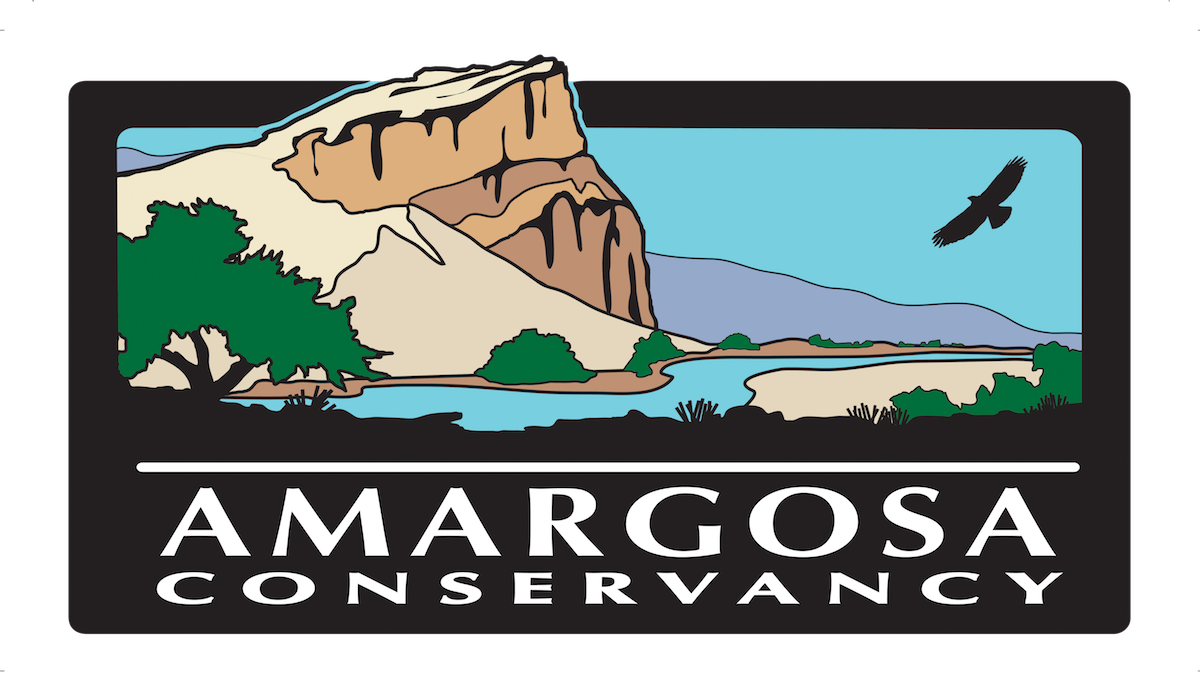
In the heart of the Amargosa River watershed, on Death Valley’s eastern shoulder, a coalition of Tribes, conservation non-profit partners, and local government leaders has rallied around a singular idea: that life and water in these arid desert lands are the same.
This is a direct response to an escalating interest in mineral exploration and lithium extraction on the doorstep of Ash Meadows National Wildlife Refuge, and near the doorsteps of homes and businesses in the nearby communities of western Nevada. Born out of concern for impact to groundwater that sustains the human and wildlife communities near Ash Meadows and Death Valley National Park, the coalition is urging leaders within the Department of the Interior and Congress to take decisive action. The call has been issued for a withdrawal of public lands from new mineral claims and exploration to enhance safeguards for this exceptionally sensitive cultural and ecological landscape.
The road to an Amargosa Valley mineral withdrawal began in the summer of 2023, when a proposed lithium exploration project on the boundary of the Ash Meadows Refuge first came to light. Ash Meadows is part of the ancestral homelands of the Timbisha Shoshone and Southern Paiute Tribes, and remains a culturally and spiritually significant site. Located just outside of Death Valley National Park, Ash Meadows includes 24,000 acres of springs, seeps, and wetlands in one of the hottest and driest deserts on Earth. Home to at least 26 endemic species that live nowhere else, Ash Meadows is a critically important biodiversity hotspot and a designated Wetland of International Importance under the United Nations.
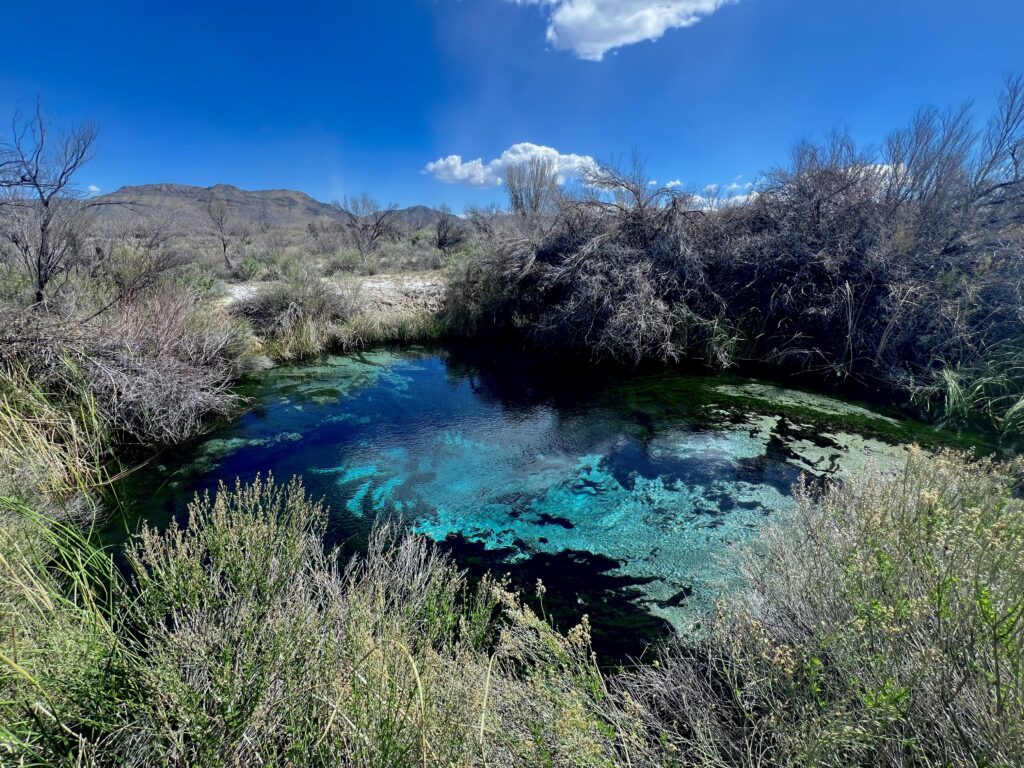
Canadian mining company Rover Critical Minerals (then named Rover Metals) submitted an application to the Bureau of Land Management (BLM) seeking to conduct a lithium exploration project that included drilling up to 30 boreholes to a depth of 300 feet on the northern boundary of the Refuge. The exploration would occur atop a groundwater flowpath of the Amargosa River known to contribute to the springs and wetlands of the refuge. The company acknowledged that they expected to encounter groundwater in every drilling location. In addition to potentially paving a path to the creation of an open-pit mine adjacent to one of the most critical biodiversity oases in North America, the exploration project itself raised significant concerns.
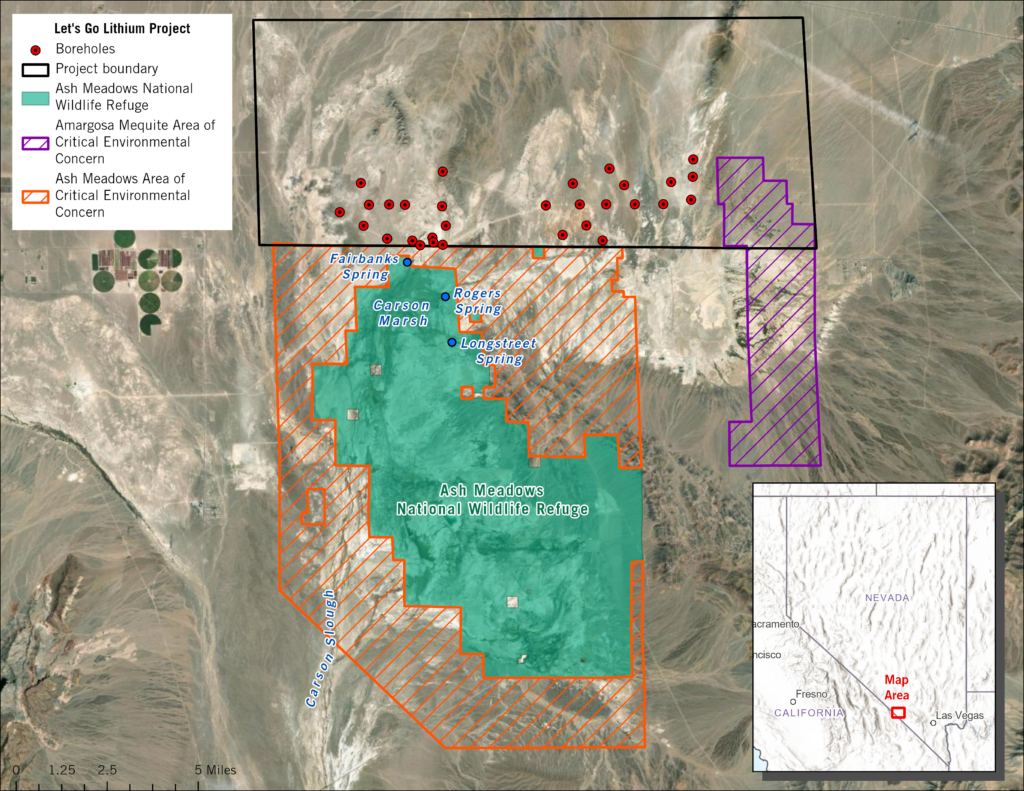
The Nature Conservancy Nevada chapter quickly commissioned a hydrological analysis to evaluate potential impacts to groundwater resources that could result from exploratory drilling in this area. This analysis indicated the potential to alter groundwater flow that sustains significant springs in the northern portion of Ash Meadows. The mining company’s closest borehole location came within just a few thousand feet of Fairbanks Spring, one of the largest springs in the refuge and home to the endangered Ash Meadows Amargosa pupfish and Ash Meadows speckled dace.
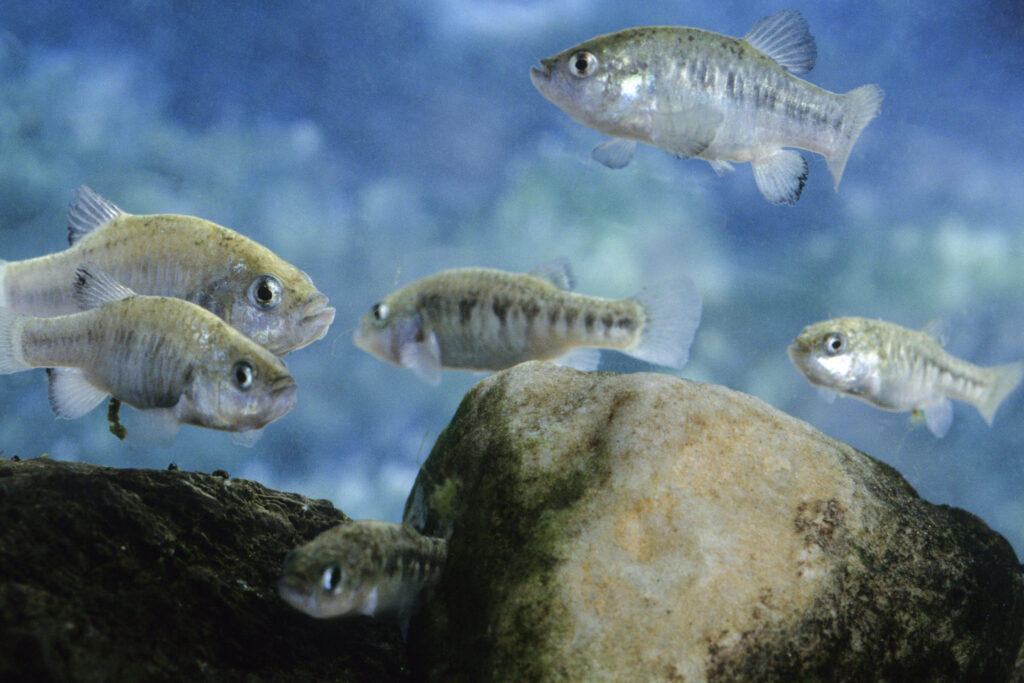
A coalition including the Timbisha Shoshone Tribe, 24 nonprofit organizations, local governments, and concerned citizens led the fight against this project over the summer and raised the alarm. As a result of public pressure and litigation filed by the Amargosa Conservancy and the Center for Biological Diversity, the BLM rescinded their approval of Rover Metals’ initial project application on July 19th, 2023. The BLM also required the company to conduct a full National Environmental Policy Act review and to submit a full Plan of Operations.
While exploratory drilling in this sensitive area presents its own risks, the biggest fear is that this project could lay a path toward the creation of an open-pit industrial mine on the doorstep of one of the most significant biodiversity hotspots in North America.
Rover Metals has already published images depicting where open-pit mining could potentially occur within their exploration area:
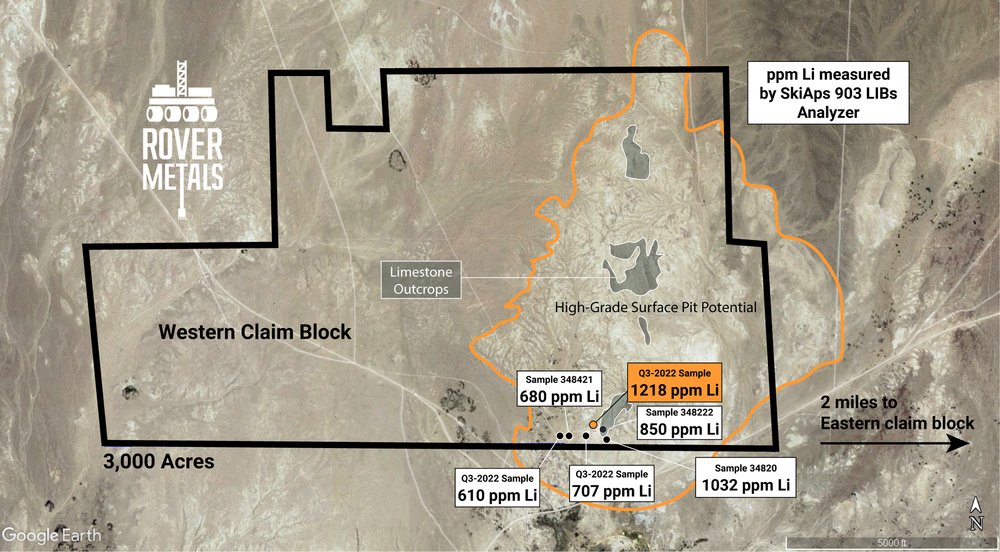
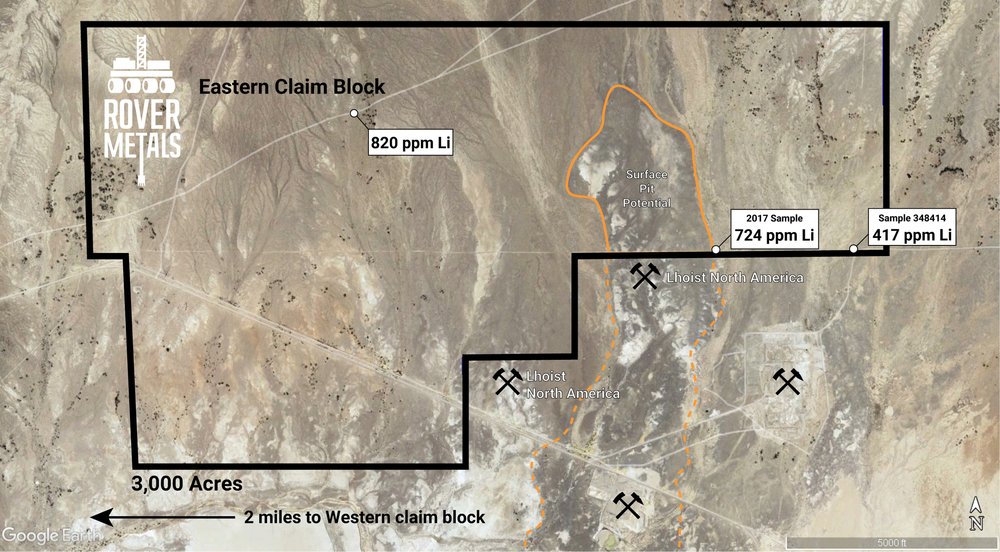
Images sourced from Rover Metals’ website
The looming prospects of exploratory drilling and open-pit mining illuminated the reality that despite 40 years of protected status and management under the U.S. Fish and Wildlife Service, Ash Meadows remains highly vulnerable to impacts from beyond its designated borders. And beyond Ash Meadows, the rural communities of this corner of the Mojave desert also came to the realization that their lives and livelihoods revolved around the sustainable conservation of groundwater. Consensus quickly formed around the notion that left unchecked, mineral exploration and industrial mining on unprotected public lands posed a potentially existential threat to communities whose lifeblood is the flow of groundwater ferried by the Amargosa River.
In recent months, formal support for withdrawal of certain public lands from new mining entry has been issued by the Timbisha Shoshone Tribe, the Amargosa Valley Town Board, the Beatty Town Advisory Board, the Nye County Board of Commissioners, the Nye County Water District, and dozens of nonprofit organizations. The diversity of this coalition which also includes numerous conservation leaders is illustrative of the true value of water in the desert, and its ability to transcend political and ideological divides. At the core of the coalition’s concerns is how alteration or depletion of groundwater would fundamentally erode a host of values – cultural, spiritual, recreational, and economic alike – and perhaps make life in this hostile environment altogether untenable. “No new ghost towns in Nye County” has become a mantra guiding the coalition’s efforts to raise awareness around the risks involved in permitting mining activities in such a landscape.
The Nature Conservancy has also commissioned a landmark study, utilizing the best available science to analyze the potential impacts of open-pit mining in this sensitive hydrological area. The results of this study demonstrate profound impacts to springs and wetlands within Ash Meadows and within the Devils Hole, a disjunct unit of Death Valley National Park contained within the refuge boundaries and sole habitat of the critically endangered Devils Hole pupfish. The study powerfully demonstrates the real risks to groundwater resources and dependent habitats and communities in Amargosa Valley, and speaks to the urgent need for these lands to receive a higher standard of protection from mining practices.
In an attempt to meet the BLM’s new review standard for the project, Rover Critical Minerals submitted a revised draft Plan of Operation in December of 2023. The slimmed-down proposal, detailing plans for 21 boreholes to a maximum depth of 150 feet, was deemed insufficient by the BLM and not accepted. Several months later, it was discovered that the company had staked nearly 8,000 additional acres of new claims on BLM lands in and around the residential center of Amargosa Valley, and less than one mile from the boundary of Death Valley National Park.
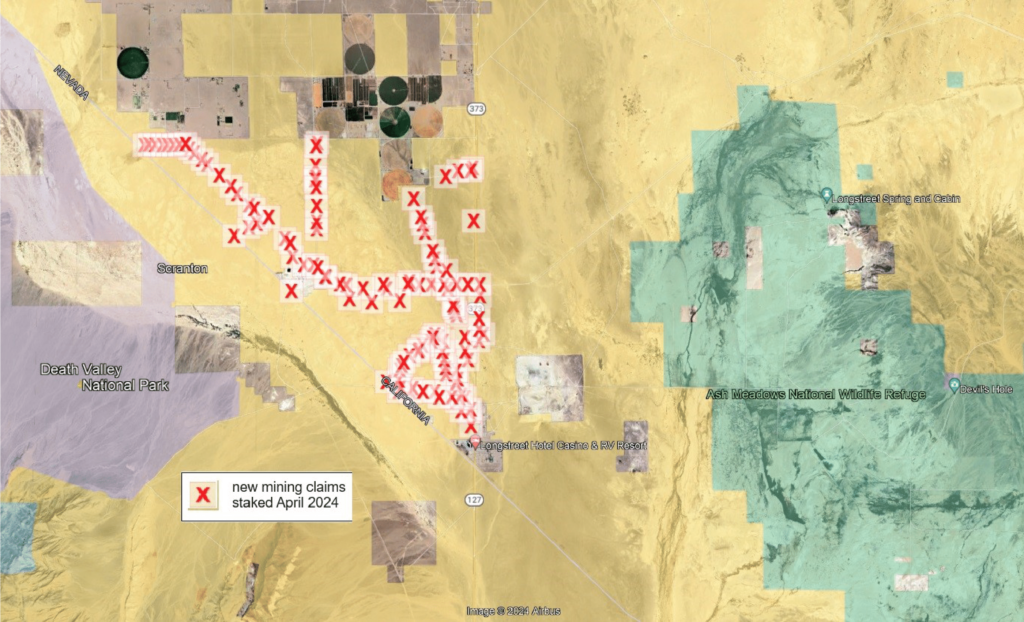
Local residents alerted their town government board of these new mining claims, some staked directly across the street and within mere feet of residences and businesses. The new project area – named the Longstreet Lithium Project by Rover Critical Minerals – entails as many as 400 new claims and is set atop an established groundwater flow path sustaining springs and domestic wells in Death Valley and on reservation lands of the Timbisha Shoshone Tribe. Claiming this new area, in the wake of the push back against Rover Critical Minerals’ initial proposal to drill near Ash Meadows has been received by some members of the tribe and Amargosa Valley residents as a redeclaration of war. Residents of both communities are once again concerned how exploratory drilling or future open-pit mining might affect their long-term water security in a basin already exhibiting signs of significant groundwater overdraft.
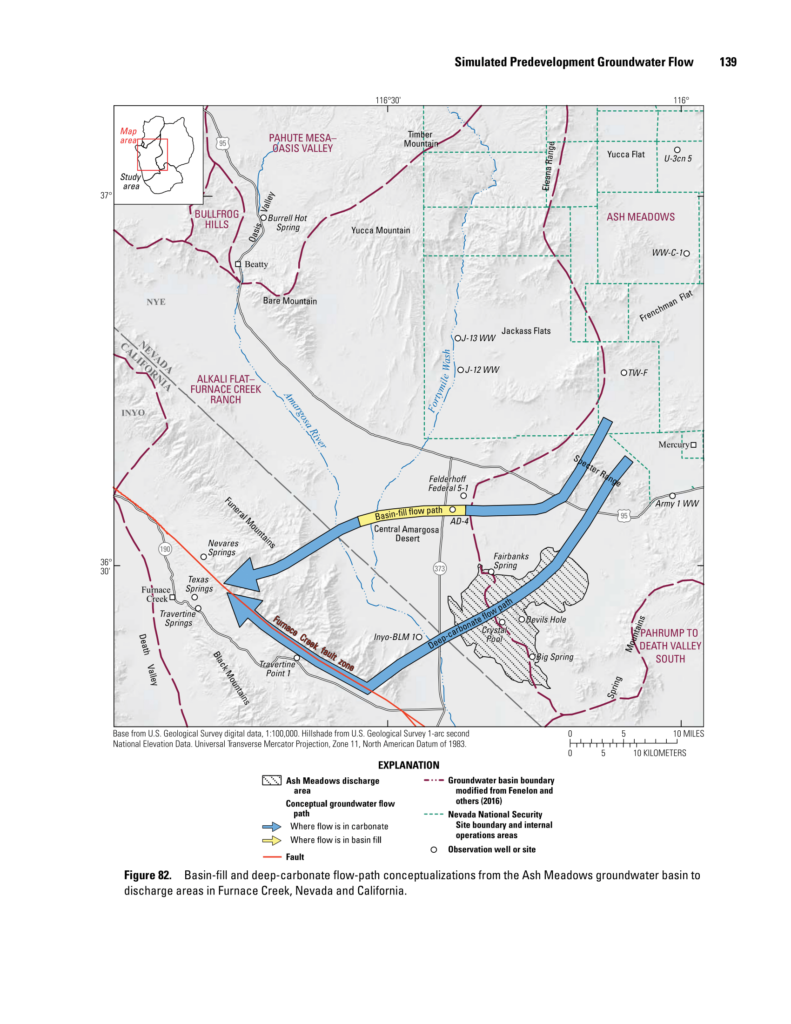
Though the mining company’s plans remain uncertain, the communities and coalition remain resolved in urgently seeking a withdrawal for public lands within Amargosa Valley. This would provide the communities with a reprieve of up to 20 years from new mineral entry. The reprieve would thus provide an opportunity to meaningfully and collaboratively discuss how to pursue the long-term water security of this portion of the Amargosa River watershed. Limiting the possibility for drastically affecting groundwater through extraction practices gone awry would be a meaningful first step on a longer road to sustainable groundwater use.
An initial analysis area has been approved by local government leaders, capturing an area of 276,121 acres of public lands to be considered for withdrawal with the aim of protecting groundwater resources relied upon by Ash Meadows, Death Valley, the Timbisha Shoshone Tribe, Amargosa Valley, and other downstream communities.
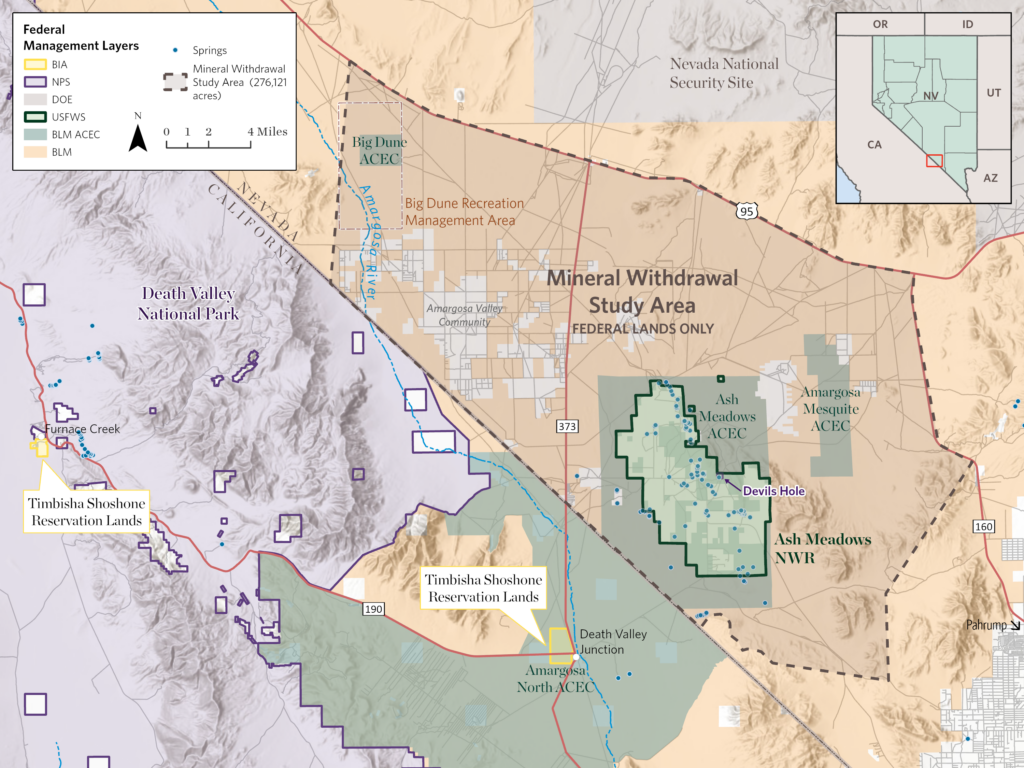
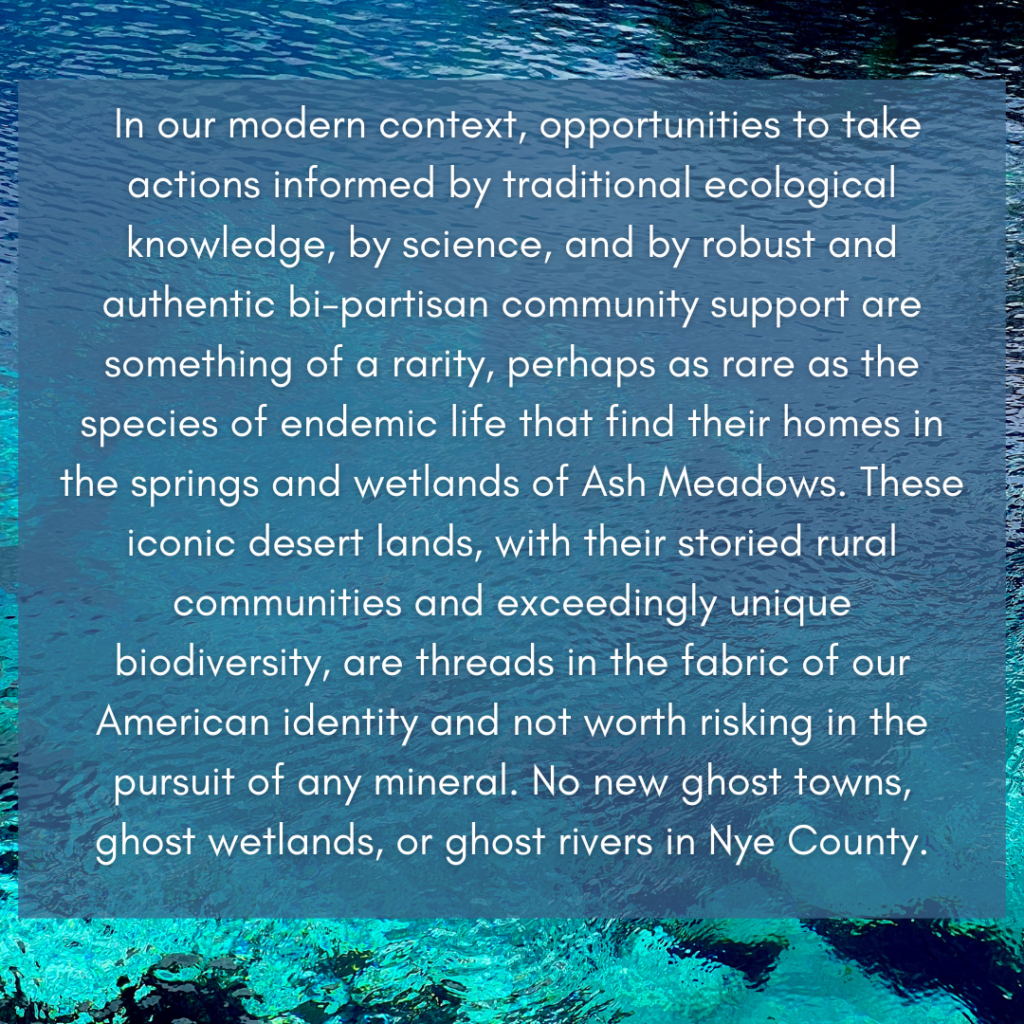
This is where you come in. Please take a few moments to raise your voice on this important issue and sign our petition urging agency leaders and elected officials to act now and save Ash Meadows.
Raise your voice in support of a safe and secure future for Ash Meadows today. Sign our petition calling for mining to be withdrawn from lands bordering the refuge.
And please, consider donating to the Amargosa Conservancy today. Your donations provide us with the means to continue to lead in this fight through advocacy, litigation, and community organizing efforts.
We can’t win this without you!
Also be sure to subscribe to our monthly digital newsletter and follow us on Facebook, Instagram, and X so that you can stay in-the-know on the latest in this fight and participate in opportunities to make an impact!
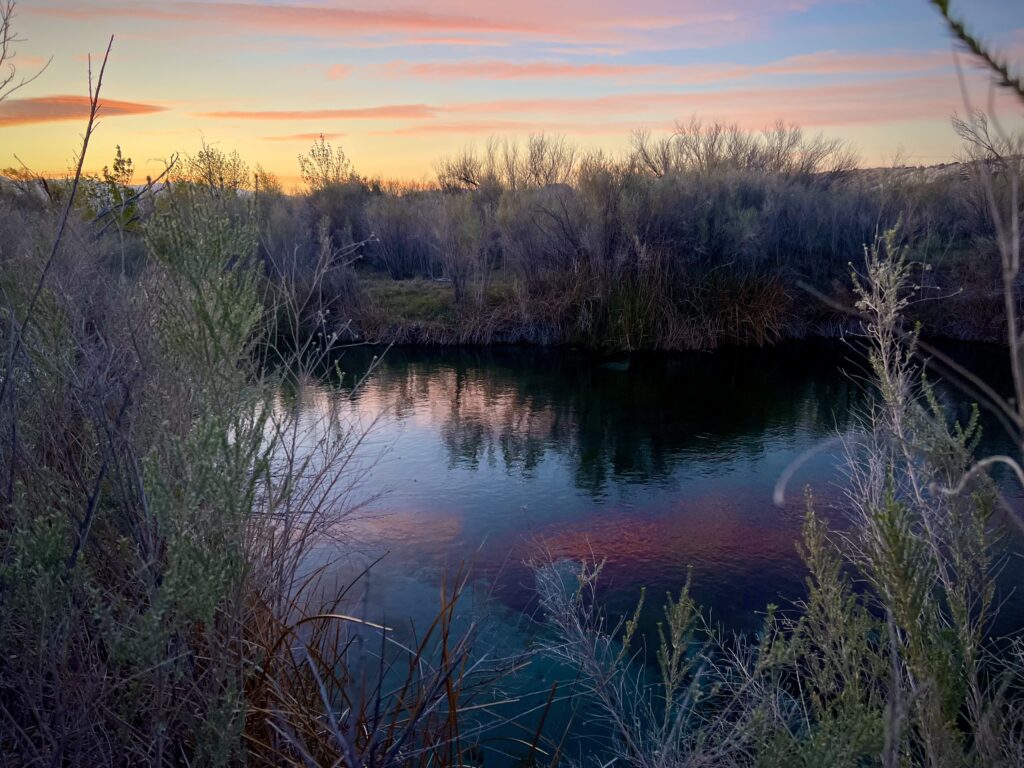
Fairbanks Spring, Ash Meadows National Wildlife Refuge; Mason Voehl

2024 SUMMER SPEAKER SERIES
Amargosa Conservancy is pleased to announce our 2024 Summer Speaker Series! This third offering of our virtual Summer Speaker Series will feature dedicated employees from the National Park Service, Bureau

A Brief Geologic Tour of the Amargosa Basin, by AC Board Member Bill Neill
A Brief Geologic Tour of the Amargosa Basin By Amargosa Conservancy board member and secretary, Bill Neill ORIGIN OF PALEOZOIC CARBONATE STRATA THAT ALLOWS LONG-DISTANCE GROUNDWATER FLOW By definition, desert
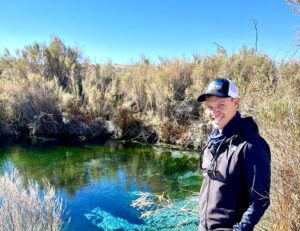
Executive Director’s Report: Amargosa Desert, a Collision Zone
Folks, it doesn’t feel like hyberbole to proclaim that our quiet little river is in a state of uproar. Believe me: I wish it wasn’t so. The phrase I keep
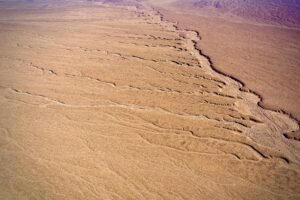
A new era of Nevada groundwater management has begun. Here’s what it could mean for the Amargosa River.
Special report from Patrick Donnelly Amargosa Conservancy Vice-President Great Basin director, Center for Biological Diversity A new era of Nevada groundwater management has begun. Here’s what it could mean for

ACTION ALERT: BLM meeting in Las Vegas on the future of solar energy in the West, including the Amargosa River watershed
Tuesday, February 13th 5:00pm-7:00pm PST Red Rock Casino, Summerlin Room CD 11011 West Charleston Blvd, Las Vegas, NV We are writing to alert you about a planning process currently being

“What is a mineral withdrawal?” Frequently Asked Questions
Not sure what a mineral withdrawal is, or why one is needed for lands surrounding Ash Meadows? This FAQ is for YOU! Frequently Asked Questions (FAQ) on Mineral Withdrawal under
